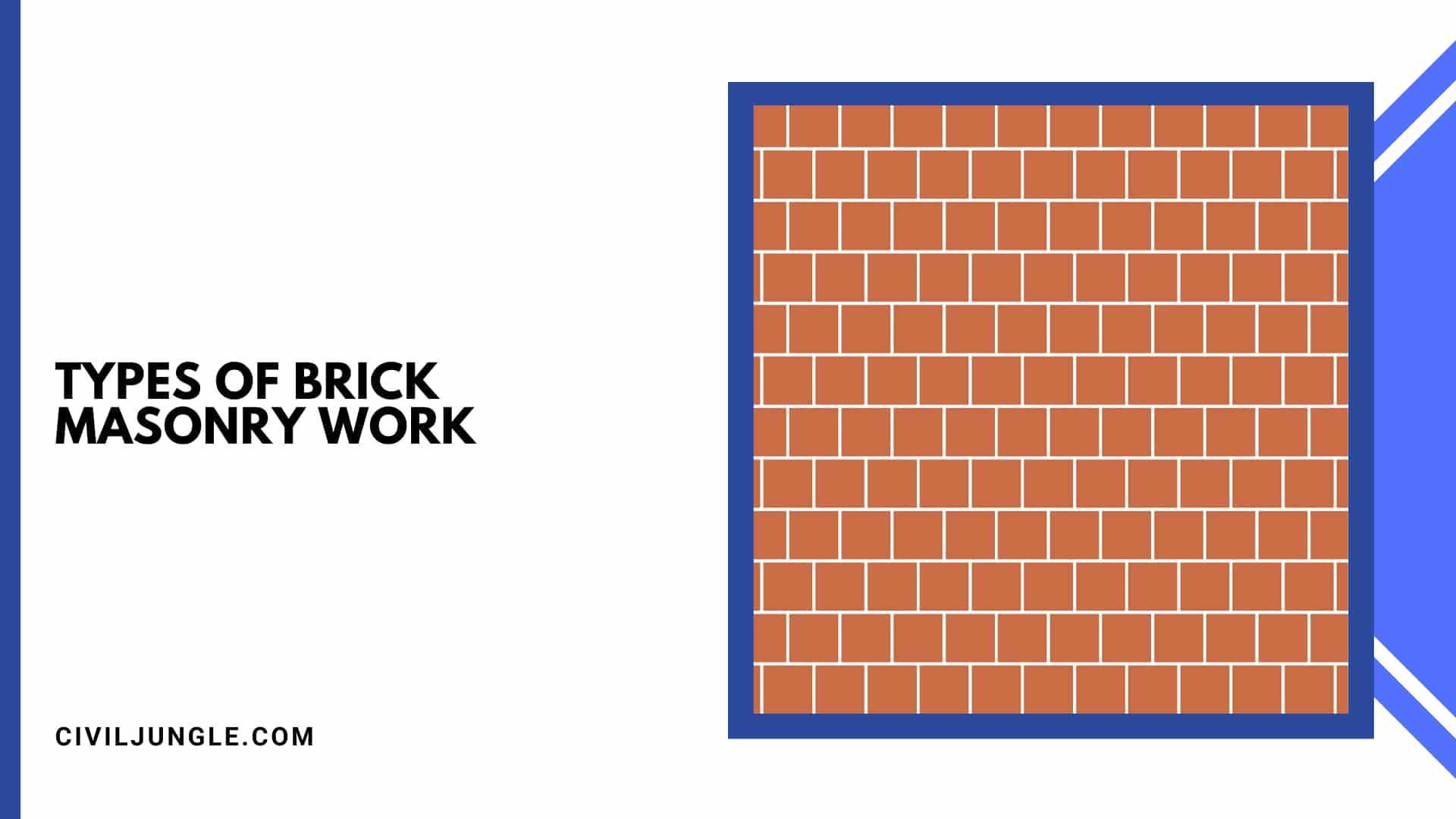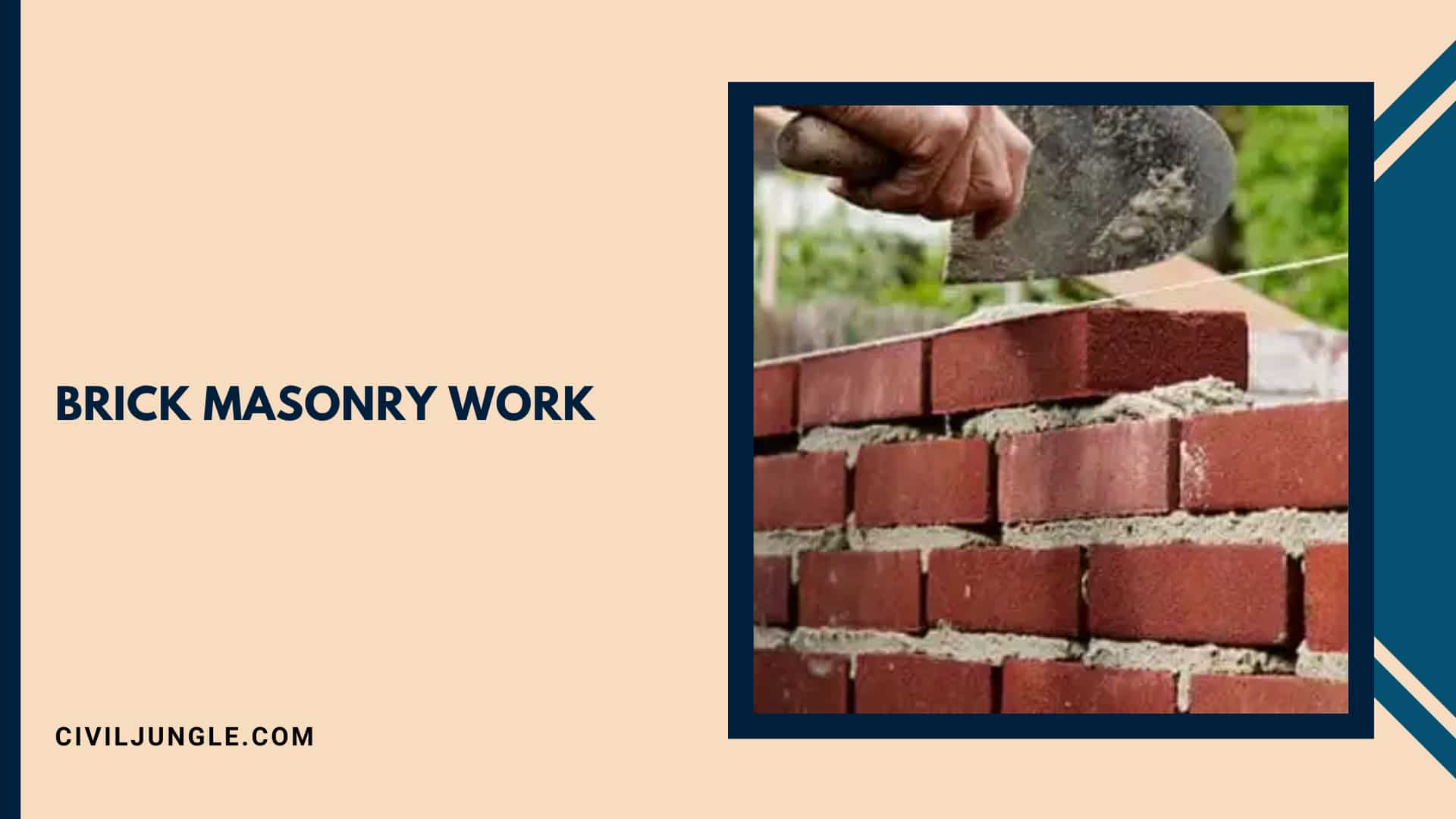Brick Masonry
Important Point
Brick masonry is an important element of the structure of a building done using bricks and cement mortar. Brick masonry is done in construction with different quality of bricks with different mixes proportional to cement mortar as required.
It is used in different parts of the building as per the requirement /architectural design of the building.
In brick masonry, bricks are defined as the placement of bricks according to the design bond to form a suitable bonding and wall together. Which can safely withstand a large amount of pressure coming from the structure of the building.
The construction of brick masonry can be found in some ancient architectural works around the world, from the pyramids of Egypt to the Great Wall of China.
What Is Brick Masonry?
Brick masonry is the process of laying bricks on a mortar bed. The wall is formed as an element in the structure of the building. Which can safely transfer the load from the superstructure to the foundation.
Lime and cement mortar is used in brick masonry in permanent types of construction. But in some cases, mud mortar is used in temporary brick masonry.
A ratio of 1: 3 is usually used for cement mortar in brick masonry. This means that one part of cement is mixed with 3 parts of sand for the preparation of cement mortar. 70% of the weight of cement for mortar is added to the water mixture.
Also, Read: Interior Paint Colors That Go with Red Brick
Brick Masonry Work
Brick masonry is a sturdy form of construction where bricks are systematically placed in a mortar to create a solid structure.
Brick is one of the most durable and versatile building materials used for both commercial and residential homes.
Types of Brick Masonry Work
1. Cement Mortar Used in Brick Masonry
Cement brick masonry involves laying bricks on a bed of cement mortar. Cement brick masonry has three classifications, as shown below.
1.1. First Class Brick Masonry in Mortar 1:4
Brick masonry is done in mortar in a 1: 4 ratio of cement and sand. This mortar has high strength in brick masonry. The following construction works are recommended for first-class brick masonry.
- In earthquake zones
- Heavyweight /load-bearing walls
- Brick pillars
- Multi-story buildings
- Brickworks used for drainage
- Partition or 4.5-inch thick walls
- Brickworks used for drainage
1.2. First Class Brick Masonry in Mortar 1:4
Second-class bricks and 1:4 proportion cement mortar are used in second-class brick masonry. These second-class bricks are not very regular or in shape.
Second-class brick has a minimum crushing strength of 70 kg per square meter. Which should not be used for load-bearing walls in two-story buildings.
1.3. Third Class Brick Work
Third-class bricks and cement mortar are used in third-class brick masonry. In any government work, third-class brick is not done in brick masonry. This type of brick masonry is usually done for temporary work in the private sector.
Also Read:
2. Brick Masonry in Mud
Mud is used as a mortar in brick masonry and is temporary work. In this masonry work, the thickness of the mortar joint is 12 mm.
This type of brick masonry is the cheapest masonry. Mud mortar is used in the construction of walls for a maximum height of 4 meters.
Brick Wall Construction Process
Materials and Equipment Used of Brick Masonry Construction
- Tape measure
- Hose, level, or theodolite
- Mortar Mix or Mason Mix Bricks
- Hammer
- Trowel Level
- Jointer
- Wheelbarrow
- Goggles
- other Equipment.
Brick Masonry Construction Preparations
First, check the soil level at the site using a theodolite or transparent level tube. Set the alignment according to the layout plan of the structure of the building.
The wall layout is marked according to the layout plan of the building using gypsum powder and chalk. Bricks are distributed in various stacks at the project site to reduce time and effort during brick masonry.
The bricks are wetted with water a few hours before work. Which avoids the brick absorbing water from the mortar. Therefore, the strength of the mortar is improved.
Brick Masonry Construction Procedure
Mortar mix properly in water. Therefore, it can be used in simple and plastic mortar brick masonry.
Then, using a trowel, place the mortar evenly along the line of the foundation in a 25mm thick.
Calculate the layer of brick for proper brick masonry height. Next, check the plumb and level of bricks of each layer constructed of brick masonry.
Place in a mortar line for the layer of brick masonry of the second course corresponding to the first course. Then, start the construction of brick masonry in the second course.
For structural purposes of brick, masonry is done using two half bricks at the beginning of the second-course layer. After laying the brick in the second course of brick masonry, a plumb and level check should be done.
In the construction of brick masonry walls, like the first course in the third and fifth layers, the stretcher and the fourth course start with a single header, then the brick masonry is formed by repeating the stretcher and header.
Point to Consider in Brick Masonry Construction
The following points should generally be supervised in the construction of brick masonry,
- The verticle of the wall should be confirmed by frequent inspections with a plumb-bob during brick masonry work.
- It should have masonry work using good-quality bricks.
- A minimum of brick bat should be used in brickwork.
- In brick masonry work, the joints are kept to a depth of 12 to 20 mm. Which can be used as a key for plastering or pointing.
- In a day, a mason will be prevented from doing walls of more than 1.5 meters in height.
- Brick masonry work should be cured regularly for two weeks.
- The layer of the brick course should be checked perfectly horizontally.
- In brick masonry construction, the thickness of the bed made of mortar should be 10 mm.
- When the brick masonry construction stops working, the bricklayer should be left with serrated ends.
Brick Masonry in the Foundation
The brick masonry work in the foundation is constructed to transfer the load of the superstructure to the ground. The width of the brick masonry in the foundation is designed according to the load placed on it.
The load of the superstructure is made in the foundation below the plinth level by various steps in brick masonry. Brick masonry for the foundation should be made according to the drawing and design.
Also Read: Transforming Your Home: Creative Red Brick Fireplace Ideas
Brick Masonry in Superstructure
Brick masonry work above the plinth level is known as brick masonry in the superstructure. The brick masonry made in the superstructure safely transfers the load of the RCC beams and slabs to the base of the walls.
In the superstructure, openings are kept in the brick masonry for the arrangement of doors, windows, and ventilators. In addition, brickwork is used to divide the required room in the building. Brick masonry in exterior walls is used for the elevation of the building.
Brick Masonry in the Parapet
The brick masonry built on the roof slab on the terrace is known as the parapet walls. Parapet walls are built to protect homeowners from falling using terraces.
The parapet wall also enhances the beauty of the building through various designs.
Brick Masonry in Partition Walls/half Brick Walls
Partition walls are used to divide the space into different sizes according to the design of the building. This type of brick wall has a thickness of 4.5 inches. Due to the thin part of the wall in the building, space can be used sparingly.
These types of walls usually do not transfer any load of the superstructure, so the room can be easily changed when the building needs an alternative. Thin walls are used economically in a building.
Advantage of Brick Masonry
- The opening of doors and windows can be easily made in the construction of brick masonry.
- Since the bricks used in brick masonry have the same shape and size, they can be easily shaped in construction.
- Brick masonry construction can be done for thin walls.
- Brick masonry usually has 25 mortar joints. Which uses less mortar than stone masonry.
- Brick masonry has more fire and weather resistance than stone masonry.
- Since brick is light in weight, in brick masonry, its installation can be done easily.
- Brick-like material is easily found around cities. Brick masonry reduces the transport cost of bricks.
- Brick masonry various mortars can be used as needed. Mud mortar can be used in Brick masonry for unimportant schemes.
- It is possible to break the brick masonry easily. Therefore, its renovation is easier and less time-consuming.
Disadvantage of Brick Masonry
- Brick masonry has less strength than stone masonry made from natural stone.
- The rough surface of brick masonry requires plastering. Brick masonry has to incur periodic maintenance costs.
- Brick masonry absorbs water in the rainy season. Therefore, the room is likely to dampness.
- Brick masonry cannot offer more natural architectural effects than stone masonry.
Like this post? Share it with your friends!
Suggested Read –
- 7 Types of Pavement Markings
- What Is Theodolite And Their Types
- Elastomeric Vs Silicone Roof Coating
- What Is Shuttering And Their Different Types
- Procedure of Slump Test And Their Advantages & Disadvantages




Leave a Reply